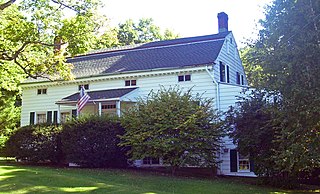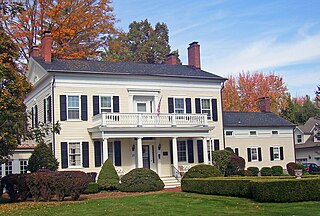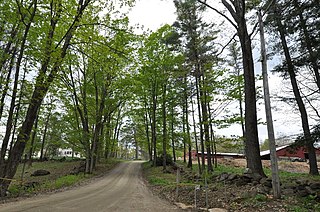
The Oliver Brewster House is a Gothic Revival home located on Willow Avenue in Cornwall, New York, United States, right across from Willow Avenue Elementary School. It was originally built as a farmhouse in the mid-19th century. Later, as Cornwall became a popular summer resort for visitors from New York City, it was expanded and renovated for use as a boardinghouse as well.

The Gilbert Millspaugh House is located on Church Street in Walden, New York, United States. It is a 2005 addition to the National Register of Historic Places, built in a Victorian style for a local man named Richard Masten. Later it was home to Gilbert Millspaugh, son of a local furniture retailer.

Montgomery Place, now Bard College: The Montgomery Place Campus, near Barrytown, New York, United States, is an early 19th-century estate that has been designated a National Historic Landmark. It is also a contributing property to the Hudson River Historic District, itself a National Historic Landmark. It is a Federal-style house, with expansion designed by architect Alexander Jackson Davis. It reflects the tastes of a younger, post-Revolutionary generation of wealthy landowners in the Livingston family who were beginning to be influenced by French trends in home design, moving beyond the strictly English models exemplified by Clermont Manor a short distance up the Hudson River. It is the only Hudson Valley estate house from this era that survives intact, and Davis's only surviving neoclassical country house.

The General John Hathorn Stone House is located on Hathorn Road in the town of Warwick, New York, United States, just off NY 94 a mile south of the village of Warwick. It was built by Hathorn in 1773 but expanded considerably in the mid-19th century.

Cannondale Historic District is a historic district in the Cannondale section in the north-central area of the town of Wilton, Connecticut. The district includes 58 contributing buildings, one other contributing structure, one contributing site, and 3 contributing objects, over a 202 acres (82 ha). About half of the buildings are along Danbury Road and most of the rest are close to the Cannondale train station .The district is significant because it embodies the distinctive architectural and cultural-landscape characteristics of a small commercial center as well as an agricultural community from the early national period through the early 20th century....The historic uses of the properties in the district include virtually the full array of human activity in this region—farming, residential, religious, educational, community groups, small-scale manufacturing, transportation, and even government. The close physical relationship among all these uses, as well as the informal character of the commercial enterprises before the rise of more aggressive techniques to attract consumers, capture some of the texture of life as lived by prior generations. The district is also significant for its collection of architecture and for its historic significance.

The John Kane House, also one of several places known as Washington's Headquarters, is located on East Main Street in Pawling, New York, United States. Built in the mid-18th century, it was home during that time to two men who confronted the authorities and were punished for it. During the Revolutionary War, George Washington used the house as his headquarters when the Continental Army was garrisoned in the area.

The Samuel Brooks House is located on Pleasant Hill Road north of the hamlet of Mountainville in the Town of Cornwall, New York, United States. It is a cottage in a mix of Victorian architectural styles, most notably Carpenter Gothic and Stick Style, built around 1860.

The Masten-Quinn House is located on First Street in the village of Wurtsboro, New York, United States. It is a wooden Greek Revival house built in two phases in the 1820s, the center of a farm that remained working until the mid-20th century. Today it is one of the few remainders from the area's agricultural past as a canal town.

Perkins Island Light is a lighthouse on the Kennebec River in Maine. It was established in 1898, as part of a major upgrade of the river's lights — the Doubling Point Light and the separate Range Lights on the point, Perkins Island Light, and Squirrel Point Light were all built at the same time. It was listed on the National Register of Historic Places as Perkins Island Light Station in 1988.

The Stephen Miller House, also known as the Van Wyck-Miller House, is located along the NY 23 state highway in Claverack, New York, United States. It is a wooden farmhouse dating from the late 18th century.

The Ephriam DuPuy Stone House is located on Whitfield Road near the hamlet of Kerhonkson, New York, United States, in the Ulster County town of Rochester. It was built in the mid-18th century.

The Terwilliger–Smith Farm is located on Cherrytown Road near the hamlet of Kerhonkson in the Town of Rochester in Ulster County, New York, United States. It was established in the mid-19th century.

Bykenhulle, originally known as Ivy Hall, is a historic house located on Bykenhulle Road near the hamlet of Hopewell Junction, New York, United States, in the Town of East Fishkill. It is a wooden house in the Greek Revival architectural style.

The Newcomb–Brown Estate is located at the junction of the US 44 highway and Brown Road in Pleasant Valley, New York, United States. It is a brick structure built in the 18th century just before the Revolution and modified slightly by later owners but generally intact. Its basic Georgian style shows some influences of the early Dutch settlers of the region.
Rushmore Farm is a historic home located at Athens in Greene County, New York. It is a 1+1⁄2-story, six-bay-wide by two-bay-deep stone dwelling surmounted by a steep gable roof. It was built in two sections during the late 18th century and early 19th century and features an overlay of Greek Revival details. Also on the property is a contributing stone smokehouse.

The Elisha Bushnell House is a historic house at 1445 Boston Post Road in Old Saybrook, Connecticut. With a construction history dating to 1678, it is one of Connecticut's oldest surviving buildings, exhibiting an evolutionary construction history. The house was listed on the National Register of Historic Places in 1978.

The John Adams Homestead/Wellscroft is a historic farmstead off West Sunset Hill Road in Harrisville, New Hampshire. The oldest portion of the farm's main house is a 1+1⁄2-story wood-frame structure built in the 1770s. It is one of the least-altered examples of early Cape style architecture in Harrisville, lacking typical alterations such as the additions of dormers and changes to the window sizes, locations, and shapes. The farmstead, including outbuildings and an area of roughly 2 acres (0.81 ha) distinct from the larger farm property, was listed on the National Register of Historic Places.

The Valentine Wightman House was a historic house at 1112 Mount Vernon Road in Southington, Connecticut. It was built around 1800 and was added to the National Register of Historic Places in 1989. It has apparently been demolished.

The Gen. Lewis R. Morris House is a historic house and farm property at 456 Old Connecticut River Road in Springfield, Vermont. Its main house, built in 1795, is well-preserved local example of Federal architecture with later Greek Revival features. The property also includes well-preserved 19th-century agricultural buildings, and was listed on the National Register of Historic Places in 1992.

The Salmon Brook Historical Society is the local historical society of Granby, Connecticut. The society's museum property is located and 208 Salmon Brook Street, and includes four historic buildings, which include museum displays of historic items, and a small research library. Two of the buildings, the Rowe and Weed Houses, are listed as a pair on the National Register of Historic Places.























